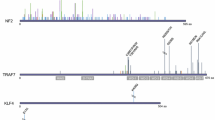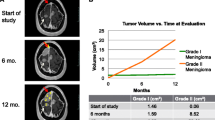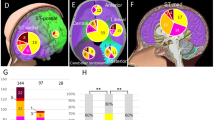Abstract
The molecular mechanisms and candidate genes involved in development of meningiomas still need investigation and elucidation. In the present study 33 meningiomas were analyzed regarding genetic changes of tumor suppressor gene Adenomatous polyposis coli (APC), a component of the wnt signaling. Gene instability was tested by polymerase chain reaction/loss of heterozygosity (LOH) using Restriction Fragment Length Polymorphism (RFLP) method. RFLP was performed by two genetic markers, Rsa I in APC’s exon 11 and Msp I in its exon 15. The results of our analysis showed altogether 15 samples with LOH of the APC gene out of 32 heterozygous patients (47%). Seven patients had LOHs at both exons, while four LOHs were exclusive for exon 11 and four for exon 15. The changes were distributed according to pathohistological grade as follows: 46% of meningothelial meningioma showed LOH; 33% of fibrous; 75% of mixed (transitional); 75% of angiomatous, and one LOH was found in a single case of psammomatous meningioma. None of the LOHs were found in atypical and anaplastic cases. Immunostaining showed that samples with LOHs were accompanied with the absence of APC protein expression or presence of mutant APC proteins (χ2 = 13.81, df = 2, P < 0.001). We also showed that nuclear localization of β-catenin correlates to APC genetic changes (χ2 = 21.96, df = 2, P < 0.0001). The results of this investigation suggest that genetic changes of APC gene play a role in meningioma formation.


Similar content being viewed by others
References
Groden J, Thliveris A, Samowitz W, Carlson M, Gelbert L, Albertsen H, Joslyn G, Stevens J, Spirio L, Robertson M (1991) Identification and characterization of the familial adenomatous polyposis coli gene. Cell 66:589–600
Gordon MD, Nusse R (2006) Wnt signalling: multiple pathways, multiple receptors, and multiple transcription factors. J Biol Chem 281:22429–22433
Peifer M, Polakis P (2000) Wnt signaling in oncogenesis and embriogenesis—a look outside the nucleus. Science 287:1606–1609
Pecina-Slaus N, Gall-Troselj K, Slaus M, Radic K, Nikuseva-Martic T, Pavelic K (2004) Genetic changes of the E-cadherin and APC tumour suppressor genes in clear cell renal cell carcinoma. Pathology 36:145–151
Koch A, Waha A, Tonn JC, Sorensen N, Berthold F, Wolter M, Reifenberger J, Hartmann W, Friedl W, Reifenberger G, Wiestler OD, Pietsch T (2001) Somatic mutations of WNT/wingless signaling pathway components in primitive neuroectodermal tumors. Int J Cancer 93:445–449
Howng SL, Wu CH, Cheng TS, Sy WD, Lin PC, Wang C, Hong YR (2002) Differential expression of Wnt genes, beta-catenin and E-cadherin in human brain tumors. Cancer Lett 183:95–101
Fogarty MP, Kessler JD, Wechsler-Reya RJ (2005) Morphing into Cancer: the role of developmental signaling pathways in brain tumor formation. J Neurobiol 64:458–475
He TC, Sparks AB, Rago C, Hermeking H, Zawel L, da Costa LT, Morin PJ, Vogelstein B, Kinzler KW (1998) Identification of c-MYC as a target of the APC pathway. Science 281:1509–1512
Kleihues P, Louis DN, Scheithauer BW, Rorke LB, Reifenberger G, Burger PC, Cavenee WK (2002) The WHO classification of tumors of the nervous system. J Neuropathol Exp Neurol 61:215–225
Riemenschneider MJ, Perry A, Reifenberger G (2006) Histological classification and molecular genetics of meningiomas. Lancet Neurol 5:1045–1054
Fuller CE, Perry A (2005) Molecular diagnostics in central nervous system tumors. Adv Anat Pathol 12:180–194
Weber RG, Bostrom J, Wolter M, Baudis M, Collins VP, Reifenberger G, Lichter P (1997) Analysis of genomic alterations in benign, atypical, and anaplastic meningiomas: toward a genetic model of meningioma progression. Proc Natl Acad Sci USA 94:14719–14724
Hall AC, Lucas FR, Salinas PC (2000) Axonal remodeling and synaptic differentiation in the cerebellum is regulated by WNT-7a signaling. Cell 100:525–535
Patapoutian A, Reichardt LF (2000) Roles of wnt proteins in neural development maintenance. Curr Opin Neurobiol 10:392–399
Yu X, Malenka RC (2003) Beta-catenin is critical for dendritic morphogenesis. Nature Neurosci 6:1169–1177
Lie DC, Colamarino SA, Song HJ, Desire L, Mira H, Consiglio A, Lein ES, Jessberger S, Lansford H, Dearie AR, Gage FH (2005) Wnt signalling regulates adult hippocampal neurogenesis. Nature 437:1370–1375
Brakeman JS, Gu SH, Wang XB, Dolin G, Baraban JM (1999) Neuronal localization of the Adenomatous polyposis coli tumor suppressor protein. Neuroscience 91:661–672
Mori T, Nagase H, Horii A, Miyoshi Y, Shimano T, Nakatsuru S, Nakatsuru S, Aoki T, Arakawa H, Yanagisawa A, Ushio Y (1994) Germ-line and somatic mutations of the APC gene in patients with Turcot syndrome and analysis of APC mutations in brain tumors. Genes Chromosomes Cancer 9:168–172
Hamilton SR, Liu B, Parsons RE, Papadopoulos N, Jen J, Powell SM, Krush AJ, Berk T, Cohen Z, Tetu B (1995) The molecular basis of Turcot’s syndrome. N Engl J Med 332:839–840
Perry A, Gutmann DH, Reifenberger G (2004) Molecular pathogenesis of meningiomas. J Neuroonco l70:183–202
Wrobel G, Roerig P, Kokocinski F, Neben K, Hahn M, Reifenberger G, Lichter P (2005) Microarray-based gene expression profiling of benign, atypical and anaplastic meningiomas identified novel genes associated with meningioma progression. Int J Cancer 114:249–256
Pecina-Slaus N (2003) Tumor suppresor gene E-cadherin and its role in normal and malignant cells. Cancer Cell Int E3:17. http://www.cancerci.com/content/3/1/17
Schwechheimer K, Zhou L, Birchmeier W (1998) E-Cadherin in human brain tumours: loss of immunoreactivity in malignant meningiomas. Virchows Arch 432:163–167
Utsuki S, Oka H, Sato Y, Kawano N, Tsuchiya B, Kobayashi I, Fujii K (2005) Invasive meningioma is associated with a low expression of E-cadherin and beta-catenin. Clin Neuropathol 24:8–12
Brunner EC, Romeike BF, Jung M, Comtesse N, Meese E (2006) Altered expression of beta-catenin/E-cadherin in meningiomas. Histopathology 49:178–187
Lee JY, Finkelstein S, Hamilton RL, Rekha R, King JT Jr, Omalu B (2004) Loss of heterozygosity analysis of benign, atypical, and anaplastic meningiomas. Neurosurgery 55:1163–1173
Acknowledgments
This work was supported by grant 108-1081870–1905 from Ministry of Science Sports and Education, Republic of Croatia.
Author information
Authors and Affiliations
Corresponding author
Rights and permissions
About this article
Cite this article
Pećina-Šlaus, N., Nikuševa Martić, T., Tomas, D. et al. Meningiomas exhibit loss of heterozygosity of the APC gene. J Neurooncol 87, 63–70 (2008). https://doi.org/10.1007/s11060-007-9500-6
Received:
Accepted:
Published:
Issue Date:
DOI: https://doi.org/10.1007/s11060-007-9500-6




